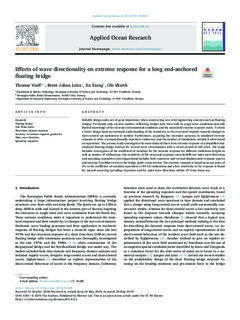| dc.contributor.author | Viuff, Thomas | |
| dc.contributor.author | Leira, Bernt Johan | |
| dc.contributor.author | Xiang, Xu | |
| dc.contributor.author | Øiseth, Ole | |
| dc.date.accessioned | 2019-12-16T11:54:04Z | |
| dc.date.available | 2019-12-16T11:54:04Z | |
| dc.date.created | 2019-07-23T14:08:28Z | |
| dc.date.issued | 2019 | |
| dc.identifier.citation | Applied Ocean Research. 2019, 90 1-11. | nb_NO |
| dc.identifier.issn | 0141-1187 | |
| dc.identifier.uri | http://hdl.handle.net/11250/2633394 | |
| dc.description.abstract | Reliable design codes are of great importance when constructing new civil engineering concepts such as floating
bridges. Previously only a scarce number of floating bridges have been built in rough wave conditions and only
limited knowledge of the extreme environmental conditions and the associated extreme response exists. To form
a better design basis an increased understanding of the sensitivity in the structural response towards changes in
short-crested sea parameters is needed. Furthermore, acquiring the necessary accuracy in simulated extreme
response is often a computationally expensive endeavour and the number of simulations needed is often based
on experience. The present study investigates the wave-induced short-term extreme response of a simplified endanchored floating bridge concept for several wave environments with a return period of 100 years. The study
includes convergence of the coefficient of variation for the extreme response for different realization lengths as
well as number of realizations. The sensitivity in the structural response towards different main wave directions
and spreading exponents is investigated and includes both transverse and vertical displacement response spectra
and extreme Von Mises stress in the bridge girder cross-section. The extreme response is based on an accuracy of
2% in the coefficient of variation equivalent to 40 3-h realizations and a low sensitivity in the response is found
for natural occurring spreading exponents and for main wave directions within 15° from beam sea. | nb_NO |
| dc.language.iso | eng | nb_NO |
| dc.publisher | Elsevier | nb_NO |
| dc.rights | Attribution-NonCommercial-NoDerivatives 4.0 Internasjonal | * |
| dc.rights.uri | http://creativecommons.org/licenses/by-nc-nd/4.0/deed.no | * |
| dc.title | Effects of wave directionality on extreme response for a long end-anchored floating bridge | nb_NO |
| dc.type | Journal article | nb_NO |
| dc.type | Peer reviewed | nb_NO |
| dc.description.version | publishedVersion | nb_NO |
| dc.source.pagenumber | 1-11 | nb_NO |
| dc.source.volume | 90 | nb_NO |
| dc.source.journal | Applied Ocean Research | nb_NO |
| dc.identifier.doi | 10.1016/j.apor.2019.05.028 | |
| dc.identifier.cristin | 1712460 | |
| dc.description.localcode | https://doi.org/10.1016/j.apor.2019.05.028 Received 31 October 2018; Received in revised form 24 May 2019; Accepted 29 May 2019 ⁎ Corresponding author. E-mail address: thomas.h.viuff@ntnu.no (T. Viuff). Applied Ocean Research 90 (2019) 101843 0141-1187/ © 2019 The Authors. Published by Elsevier Ltd. This is an open access article under the CC BY license (http://creativecommons.org/licenses/BY/4.0/). | nb_NO |
| cristin.unitcode | 194,64,20,0 | |
| cristin.unitcode | 194,64,45,0 | |
| cristin.unitname | Institutt for marin teknikk | |
| cristin.unitname | Institutt for konstruksjonsteknikk | |
| cristin.ispublished | true | |
| cristin.fulltext | original | |
| cristin.qualitycode | 1 | |

